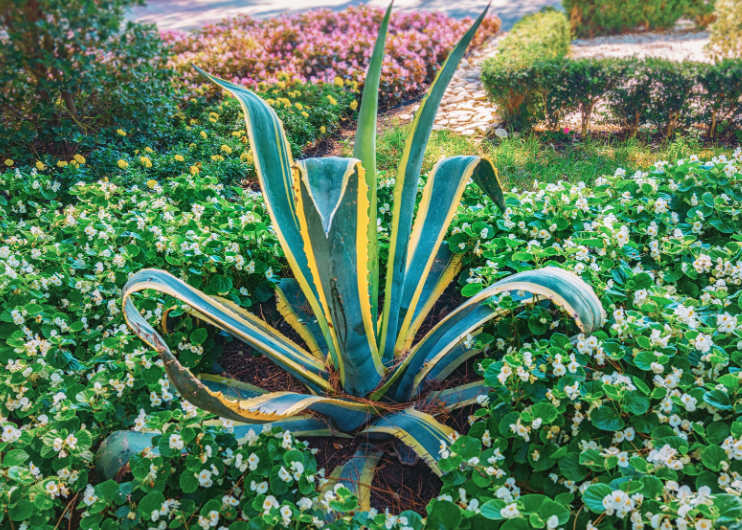Agave Americana

Century plant, Agave americana, is a Big growing succulent that is a very common landscape specimen in the warmer sections of the desert Southwest but grows equally well in Florida.
The common name comes from the misconception that it takes this plant 100 years to flower. In reality, a century plant only takes 10 to 30 years before flowering occurs.
Once mature, it can produce an inflorescence 10 to 30 feet tall. After several months, the flowering process is finished and the plant dies.
Look Sharp
Century plant grows in clumps and can form large specimens 5 to 7 feet tall and 8 to 10 feet across. The succulent leaves grow in a basal rosette.
They are usually straight and upright but sometimes curve at the tips. They range in color from grayish-green to blue-green. The leaves are armed with a sharp spine at the tips and curved spines along the edges.
The Tolerant Type
Century plant grows best in full sun but can handle light shade. It can survive with just natural rainfall but also can be grown in irrigated landscapes, provided they have well-drained soil.
A high salt tolerance means that it can be grown along front-line dunes, too.
Century plant is propagated by seeds, offshoots, or by plantlets that form on the inflorescence.
Agave americana is a plant in the Asparagaceae family that grows in a variety of temperatures and elevations all over the world, except in the frigid zone. 13
Among the 200–300 species known worldwide, Ethiopia has twenty species and six genera of this plant. 14–16
Despite being regarded as an aggressive plant in areas of southern Africa, Agave americana is frequently planted for ornamental purposes due to its pale yellow edge leaves and ease of breeding and cultivation.
Previously, seasonal and age-related variations in certain leaf components were observed.
Century Plant Facts
- It is part of a large family known as the Agavaceae, which also includes Agave tequiliana, the plant tequila is made from.
- They grow naturally in Central America but can be found in the southwest U.S.
- The plant will bloom when it’s anywhere from 10 to 40 years old.
- After flowering for about a week, the entire plant dies.
- The plant prefers sandy-dry soil and cannot grow in the shade.
- The plant’s heart, which is sweet and healthy yet fibrous when baked, can be eaten.
- Agave sap has long been utilized in Central America as a binding agent for various powders and to heal painful or inflamed body parts.
- The sap can also be consumed internally to treat diarrhea or dysentery.
- Sap from the cut flowering stems can be used as a syrup.
- Water in which agave fiber has been soaked for a day can be used as a scalp disinfectant and has also been used as a tonic in cases of hair loss.

























